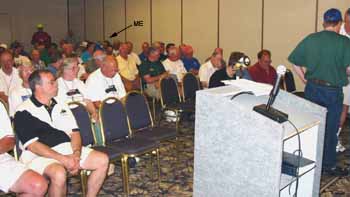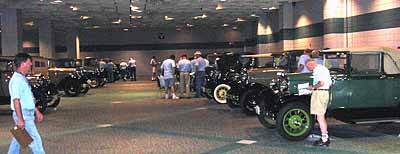
FINE POINT GREEN BAY 2002

FINE POINT GREEN BAY 2002
Since the late 60's I've been wanting to 'do' a fine point car but life kept getting in the way. I still have that goal in mind, and life is still getting in the way, but in the mean time, I decided to work on becoming a judge so as to better understand the process. I requested, received and passed the 23 test necessary to be an apprentice judge for MAFCA. To be able to apprentice judge for MARC, you need to attend one of the many seminars put on by MARC. I then attended the National MARC meet at Green Bay and finagled my way into judging. I have also be fortunate enough to Judge at the Dearborn national MARC meet.
Prior to the meet the head judge (not sure of the exact title), assigned judges to be in charge of several areas, These Judges then had area leaders assigned under them. Then finally the individual judges for each area where assigned. I was assigned to Area 4, undercarriage. The team was made up of 4 people, the area Leader, two judges and two apprentice judges.

Prior to judging we met with the area leader and was
instructed on procedures to follow. All cars were to be
judged by what was written on the window display card. If the
car was a 1928, and it was identified as 1930. It would be
judged as a 1930. . If you called it a cabriolet, and it was
a sport coupe, it would be judged as a cabriolet. (ouch!) All
cars start with 500 points. Deductions were made based on our
inspection, and if we were unsure, the point went to the
owner. Half points could be deducted. When the final tally
was made, if there was a half point it would be rounded up.
I.E. 450.5 points would be rounded to 451. During this
meeting we were instructed not to judge the gloss on the
undercarriage, and to allow paint on the 'unfinished' parts
for preservation. We were told to that heavy handiness' on
the 'paint for preservation would be considered. Also we were
to confine our judging and statements to the undercarriage.
The other areas were verboten, and would not be discussed.
The judging was to be equal for all cars. If a point was
taken on one car, if the same problem was found on other
cars, a point would be taken for that car as well. We were
also given the score sheets, and made familiar with the
process. A typical score sheet can be found in the front of
the Judging Standards. The individual items under each area
would be scored after discussion and the abbreviation for the
deduction would be entered on the score sheet. As example, if
the incorrect assembly was found IA was entered. The score
sheets would then added up for that area, signed by the area
leader and passed up the chain to be tallied with the other
areas. Any time a score below the red alert was entered, it
would be discussed with the next higher judge and a short
explanation would be written.
The undercarriage is worth 35 points and is divided into 4 segments.
Please note that only the undercarriage was to be judged. That is to say, the bumper brackets were to be judged not the bumper. The battery carrier, not the battery.
Each area is then inspected for the following 8 items.
As you can see some of these areas overlap and it becomes a judgment call. Is a under restored part improper restoration, or is it condition?

FINE POINT AT DEARBORN 2003
The procedure I followed for inspection was thus:
First I check to see if the bumpers and car sat level. If it did not I then would look for a twisted, bent, or sagging bumper bracket or frame. Then I looked at the distance the bumper was from the tire, or back of the fenders to see if the brackets were bent. I then looked at the bumper brackets. Were the ends round or square cut (correct year), Were the bars pitted, or were they sanded and filled to gloss finish? Either would be deductions. Was the proper assembly followed. Where the heads of the bolts facing the correct direction? Where modern fasteners used? Wer the finishes correct (no plated parts where there shouldn't be etc.). Were there lock washers, where required? What was the overall workmanship like. And on down the line.
I was amazed to find that on some cars the bars looked powder coated and were as glossy as the fenders. That the bumper was nearly rubbing a tire on one side and a reasonable distance on the others (no the tires weren't turned). That there was primer showing or paint over dirt. I was also pleased to find cars with extremely well done restorations.
Next I would look at the front axle. Was the correct year used. Was the correct of 3 king pin locking bolts used? The tie rod was straight and correct? Was the drag link rubbing? Grease fittings correct? Pitman arm correct year based on the grease seal flange etc. ? Spindle arms? Slop in the drag link / tie rod? Round bottom or square bottom castellated nuts? Cotter pins correct and installed correctly? Correct number of leaves in the front spring? Clipped corners on the spring leaves? Spring sagging? Spring rebound clips riveted or bolted? Which way was the bolt facing? Correct front cross member? Condition / workmanship / finishes? Again, I found the wrong year parts, missing or incorrectly installed cotters, heavy paint, no paint, sanded ready for the next coat, pits, worn drag links, modern grease fittings, king pin locks installed backwards. I also found cars that were a joy to look at.
If at any time I was unsure, I would consult the standards. I would also ask the area leader for his 'take' on it.
Well, you get the idea. After we finished judging all four areas we would discuss what we found by sub area. We would double check things that someone found and others didn't. And then give our recommendation for the score in that area. We would then come to a consensus. The well done cars were easy. The discussion would amount to 'Wow! that is a really nice car! Full points' The cars with problems were extremely hard. We would do everything we could, NOT to take points, but at times we had no choice. The poorly done cars were the worst. As soon as the red alert was hit, we all started to feeling bad. At some points we would just stop, and say we wouldn't deduct any more points.
Was the process fair? YES! As fair as was humanly possible. I found that I was actually harder on the cars than the other judges. I didn't like the fact that we weren't to judge the gloss on the sprayed parts vs. the dipped parts. That unfinished parts could be painted with a non clear finish. (I know the frames were sometimes given a shot of paint to cover any damage to the finish during assembly, and that the over spray could go everywhere, but these weren't assembled that way. I guess that's over restoring on my part.).
Judging is not a mystical process. If you read, understand, and follow the Judging standards and use good workmanship your car should score very well. READ the standards, even the front sections on judging. There is good information on every page. If your front axle needs a large Ford script, use an axle with a large Ford script. Follow good workmanship habits. Learn the way a cotter pin is installed. Cut and peen the center bolt in the springs, if for no other reason than safety. Stop the leaks or at least be sure it's not leaking at the time of judging. Learn where the spot welds on the battery box are located. Don't use modern fasteners. Use original parts and if the original part can't be found, at least properly install the repop part. Learn that this is a restoration not a 'show' car. That is to say not everything is filled, sanded and painted to a high gloss. Don't over restore! and at the same time, don't half fast it either.
Nor is judging political. During both judging's I never knew who entered what car..nor did I care. I never heard anyone saying 'Oh, this is so and so's car..score it higher (or lower)'. Nor did I hear 'this car was done at a big name shop..it should score better'. Each car was compared to the standards. Each car was given the benefit of the doubt. Each car was judged to the standards not to other cars.
Every car has compromises in it. There has never been a 500 point car. If you fairly judge your own car, you will find that you can make decisions on what points you will go for, and what you will let go.
I hope this little article has helped in some way to dispel the myths about fine point judging. And that it takes some of the fear out of the process. And I really hope that if nothing else, it encourages you to do the best restoration you can, following the standards as much as possible.
I thoroughly enjoyed the experience of judging, and would recommend it to anyone interested in the Model A, even if you never plan to enter a car to be fine point judged. It was a great learning experience. I learned more about the undercarriage then I thought possible, and I learned how to better understand the Standards. If nothing else you get to get up close with some of the finest restorations in the country. Now it's time for me to put my money where my mouth is.....
Page designed by Jim Mason July, 2007